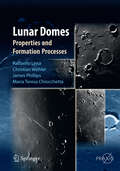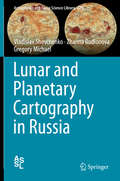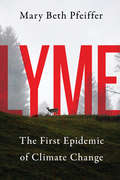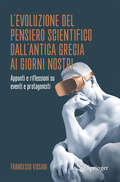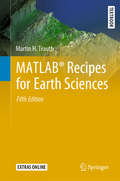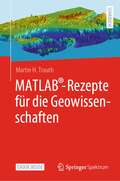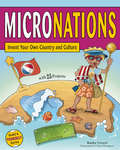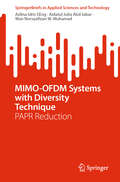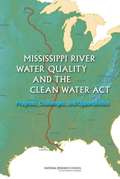- Table View
- List View
Luminescence Dating in Archaeology, Anthropology, and Geoarchaeology: An Overview
by Annette Kadereit Ioannis Liritzis Sheng-Hua Li Rudolf Wagner Jim Feathers Nikolaos Zacharias Ashok SinghviThe field of Luminescence Dating has reached a level of maturity. Both research and applications from all fields of archaeological science, from archaeological materials to anthropology and geoarchaeology, now routinely employ luminescence dating. The advent of optically stimulated luminescence (OSL) techniques and the potential for exploring a spectrum of grain aliquots enhanced the applicability, accuracy and the precision of luminescence dating. The present contribution reviews the physical basis, mechanisms and methodological aspects of luminescence dating; discusses advances in instrumentations and facilities, improvements in analytical procedures, and statistical treatment of data along with some examples of applications across continents, covering all periods (Middle Palaeolithic to Medieval) and both Old and New World archaeology. They also include interdisciplinary applications that contribute to palaeo-landscape reconstruction.
Luminescence Signal Analysis Using Python
by Vasilis PagonisThis book compiles and presents a complete package of open-access Python software code for luminescence signal analysis in the areas of radiation dosimetry, luminescence dosimetry, and luminescence dating. Featuring more than 90 detailed worked examples of Python code, fully integrated into the text, 16 chapters summarize the theory and equations behind the subject matter, while presenting the practical Python codes used to analyze experimental data and extract the various parameters that mathematically describe the luminescence signals. Several examples are provided of how researchers can use and modify the available codes for different practical situations. Types of luminescence signals analyzed in the book are thermoluminescence (TL), isothermal luminescence (ITL), optically stimulated luminescence (OSL), infrared stimulated luminescence (IRSL), timeresolved luminescence (TR) and dose response of dosimetric materials. The open-access Python codes are available at GitHub.The book is well suited to the broader scientific audience using the tools of luminescence dosimetry: physicists, geologists, archaeologists, solid-state physicists, medical physicists, and all scientists using luminescence dosimetry in their research. The detailed code provided allows both students and researchers to be trained quickly and efficiently on the practical aspects of their work, while also providing an overview of the theory behind the analytical equations.
Luminescence: Data Analysis and Modeling Using R (Use R!)
by Vasilis PagonisThis book covers applications of R to the general discipline of radiation dosimetry and to the specific areas of luminescence dosimetry, luminescence dating, and radiation protection dosimetry. It features more than 90 detailed worked examples of R code fully integrated into the text, with extensive annotations. The book shows how researchers can use available R packages to analyze their experimental data, and how to extract the various parameters describing mathematically the luminescence signals. In each chapter, the theory behind the subject is summarized, and references are given from the literature, so that researchers can look up the details of the theory and the relevant experiments. Several chapters are dedicated to Monte Carlo methods, which are used to simulate the luminescence processes during the irradiation, heating, and optical stimulation of solids, for a wide variety of materials. This book will be useful to those who use the tools of luminescence dosimetry, including physicists, geologists, archaeologists, and for all researchers who use radiation in their research.
Lunar Domes: Properties and Formation Processes
by Christian Wöhler Jim Phillips Maria Teresa Chiocchetta Raffaello LenaLunar domes are structures of volcanic origin which are usually difficult to observe due to their low heights. The Lunar Domes Handbook is a reference work on these elusive features. It provides a collection of images for a large number of lunar domes, including telescopic images acquired with advanced but still moderately intricate amateur equipment as well as recent orbital spacecraft images. Different methods for determining the morphometric properties of lunar domes (diameter, height, flank slope, edifice volume) from image data or orbital topographic data are discussed. Additionally, multispectral and hyperspectral image data are examined, providing insights into the composition of the dome material. Several classification schemes for lunar domes are described, including an approach based on the determined morphometric quantities and spectral analyses. Furthermore, the book provides a description of geophysical models of lunar domes, which yield information about the properties of the lava from which they formed and the depth of the magma source regions below the lunar surface.
Lunar and Planetary Cartography in Russia
by Vladislav Shevchenko Zhanna Rodionova Gregory MichaelThis book is the first to document in depth the history of lunar and planetary cartography in Russia. The first map of the far side of the Moon was made with the participation of Lomonosov Moscow University (Sternberg Astronomical Institute, MSU) in 1960. The developed mapping technologies were then used in preparing the "Complete Map of the Moon" in 1967 as well as other maps and globes. Over the years, various maps of Mars have emerged from the special course "Mapping of extraterrestrial objects" in the MSU Geography Department, including the hypsometric map of Mars at a scale of 1:26,000,000, compiled by J. A. Ilyukhina and published in 2004 in an edition of 5,000 copies. A more detailed version of this map has since been produced with a new hypsometric scale. In addition, maps of the northern and southern hemispheres of Mars have been compiled for the hypsometric globe of Mars. Relief maps of Venus were made in 2008, 2010, and 2011, and hypsometric maps of Phobos and Deimos at a scale of 1:60,000 were published in 2011. History of Lunar and Planetary Cartography in Russia provides detailed information on the compilation of this diverse range of maps and will be of interest to all lunar and planetary cartographers.
Luxury Fashion Brand Management: Unifying Fashion with Sustainability (Mastering Fashion Management)
by Olga MitterfellnerThis textbook examines fashion luxury brand management, providing students with a comprehensive understanding of its origins, unique components, current practices, global trade and, most importantly, the application of sustainable models to the industry. It also highlights what makes brands fail and how they can become more resilient. The key content covers the heritage of luxury brands, the importance of craftsmanship and creative direction, the role of luxury conglomerates, cultural awareness and internationalisation, risks of failure and opportunities for revitalisation as well as the application of sustainable measures for a resilient and ethical brand future. Each chapter includes a combination of industry insights, case studies or expert interviews. Coupled with theoretical frameworks and business models, these examples and case studies show how sustainable models can be applied to existing luxury brands and how practices can be embedded into the brand concept. Students are encouraged to think about opportunities and solutions, unique to luxury brand management, and will gain knowledge and skills for a successful future career. A truly global and holistic textbook, Luxury Fashion Brand Management and Sustainability should be core and recommended reading for advanced undergraduate and postgraduate students studying luxury fashion management, luxury brand management, sustainable fashion and responsible business and fashion marketing and communications. Supplementary online resources include chapter-by-chapter PowerPoint slides and a test bank.
Lyme: The First Epidemic of Climate Change
by Mary Beth PfeifferLyme disease is spreading rapidly around the globe as ticks move into places they could not survive before. The first epidemic to emerge in the era of climate change, the disease infects half a million people in the US and Europe each year, and untold multitudes in Canada, China, Russia, and Australia.Mary Beth Pfeiffer shows how we have contributed to this growing menace, and how modern medicine has underestimated its danger. She tells the heart-rending stories of families destroyed by a single tick bite, of children disabled, and of one woman's tragic choice after an exhaustive search for a cure.Pfeiffer also warns of the emergence of other tick-borne illnesses that make Lyme more difficult to treat and pose their own grave risks. Lyme is an impeccably researched account of an enigmatic disease, making a powerful case for action to fight ticks, heal patients, and recognize humanity's role in a modern scourge.
Límites Socioculturales de la Educación Ambiental (Acercamiento desde la experiencia cubana)
by Carlos Jesús Delgado DíazEs evidente que el progreso científico-tecnológico, el bienestar de las sociedades industrializadas y el deterioro del medio ambiente se encuentran profundamente relacionadas. Al minarse las bases de los ciudadanos, la preocupación social por lo ambiental se ha manifestado como una institución social de ese vínculo con la naturaleza demandando una nueva educación que incluya la reflexión y modificación de su relación material con el mundo.
L’evoluzione del pensiero scientifico dall’antica Grecia ai giorni nostri: Appunti e riflessioni su eventi e protagonisti
by Francesco VissaniLa scienza, come ogni cosa al mondo, ha avuto un inizio, un'origine. Sebbene non si possa stabilire con precisione il momento esatto degli esordi, il contributo della civiltà greca, come ampiamente attestato dai documenti, è stato cruciale; molti, tra cui l’autore, lo considerano essenziale per la nascita della scienza come la conosciamo. Il libro esplora l'evoluzione del pensiero scientifico con una raccolta di appunti e saggi che, procedendo in ordine cronologico ma senza seguire una struttura rigida, mantiene la lettura istruttiva e interessante. Si esaminano le prime forme assunte dalla scienza, la fioritura dell'ellenismo, la sua crisi e la sua rinascita, con particolare attenzione ai rapporti con la filosofia. Il viaggio inizia con i presocratici e i pitagorici, concentrandosi su Democrito, Platone e Archimede, e continua con un breve passaggio nell'era romana. Continua con il periodo arabo, per passare al Medioevo, con un riferimento a Dante; giunge infine al Rinascimento e ai pensatori moderni tra cui Galilei. Nell'ultima parte viene presentata la storia di alcune delle grandi scoperte della fisica, evidenziandone le relazioni con il pensiero antico; si conclude ragionando di situazioni contemporanee.
M8.0 Wenchuan Earthquake
by Huilin Xing Xiwei XuThe M8.0 Wenchuan Earthquake occurred in China on May 12, 2008, killing over 69,000 people and displacing millions from their homes. This was one of the most catastrophic natural disasters on record. This book includes 5 chapters describing the tectonic setting and historical earthquakes around the Chuan-Dian region, the nucleation of the Wenchuan earthquake, occurrence and aftershocks. The field observations of earthquake induced surface fractures and building damage, form a major and special part of this book and include a large number of digital photos with accompanying explanantions.
MARS Applications in Geotechnical Engineering Systems: Multi-Dimension with Big Data
by Wengang ZhangThis book presents the application of a comparatively simple nonparametric regression algorithm, known as the multivariate adaptive regression splines (MARS) surrogate model, which can be used to approximate the relationship between the inputs and outputs, and express that relationship mathematically. The book first describes the MARS algorithm, then highlights a number of geotechnical applications with multivariate big data sets to explore the approach’s generalization capabilities and accuracy. As such, it offers a valuable resource for all geotechnical researchers, engineers, and general readers interested in big data analysis.
MATLAB with Applications to Engineering, Physics and Finance
by David Baez-LopezMaster the tools of MATLAB through hands-on examplesShows How to Solve Math Problems Using MATLABThe mathematical software MATLAB integrates computation, visualization, and programming to produce a powerful tool for a number of different tasks in mathematics. Focusing on the MATLAB toolboxes especially dedicated to science, finance, and engineering
MATLAB® Recipes for Earth Sciences
by Martin H. TrauthMATLAB® is used for a wide range of applications in geosciences, such as image processing in remote sensing, the generation and processing of digital elevation models and the analysis of time series. This book introduces methods of data analysis in geosciences using MATLAB, such as basic statistics for univariate, bivariate and multivariate datasets, time-series analysis, signal processing, the analysis of spatial and directional data and image analysis. The revised and updated Fourth Edition includes sixteen new sections and most chapters have greatly been expanded so that they now include a step by step discussion of all methods before demonstrating the methods with MATLAB functions. New sections include: Array Manipulation; Control Flow; Creating Graphical User Interfaces; Hypothesis Testing; Kolmogorov-Smirnov Test; Mann-Whitney Test; Ansari-Bradley Test; Detecting Abrupt Transitions in Time Series; Exporting 3D Graphics to Create Interactive Documents; Importing, Processing and Exporting LANDSAT Images; Importing and Georeferencing TERRA ASTER Images; Processing and Exporting EO-1 Hyperion Images; Image Enhancement; Correction and Rectification; Shape-Based Object Detection in Images; Discriminant Analysis; and Multiple Linear Regression. The text includes numerous examples demonstrating how MATLAB can be used on data sets from earth sciences. The book's supplementary electronic material (available online through Springer Link) includes recipes that include all the MATLAB commands featured in the book and the example data.
MATLAB® Recipes for Earth Sciences (Springer Textbooks in Earth Sciences, Geography and Environment)
by Martin H. TrauthMATLAB® is used in a wide range of geoscientific applications, such as for image processing in remote sensing, for generating and processing digital elevation models, and for analyzing time series. This book introduces methods of data analysis in the earth sciences using MATLAB, such as basic statistics for univariate, bivariate, and multivariate data sets, time series analysis, signal processing, spatial and directional data analysis, and image analysis. The text includes numerous examples demonstrating how MATLAB can be used on data sets from the earth sciences. The supplementary electronic material (available online through Springer Link) contains recipes that include all the MATLAB commands featured in the book and example data.
MATLAB® Recipes for Earth Sciences: Matlab® And Design Recipes For Earth Sciences (Springer Textbooks in Earth Sciences, Geography and Environment)
by Martin H. TrauthMATLAB® is used in a wide range of geoscientific applications, e.g. for image processing in remote sensing, for creating and processing digital elevation models, and for analyzing time series. This book introduces readers to MATLAB-based data analysis methods used in the geosciences, including basic statistics for univariate, bivariate and multivariate datasets, time-series analysis, signal processing, the analysis of spatial and directional data, and image analysis. The revised and updated Fifth Edition includes seven new sections, and the majority of the chapters have been rewritten and significantly expanded. New sections include error analysis, the problem of classical linear regression of log-transformed data, aligning stratigraphic sequences, the Normalized Difference Vegetation Index, Aitchison’s log-ratio transformation, graphical representation of spherical data, and statistics of spherical data. The book also includes numerous examples demonstrating how MATLAB can be used on datasets from the earth sciences. The supplementary electronic material (available online through SpringerLink) contains recipes that include all the MATLAB commands featured in the book and the sample data.
MATLAB®-Rezepte für die Geowissenschaften
by Martin H. TrauthTrauth, Martin H.MATLAB® - Rezepte für Geowissenschaften, 1. deutschsprachige Auflage, basierend auf der korrigierten 5. englischsprachigen AuflageMATLAB® wird in einer Vielzahl von geowissenschaftlichen Anwendungen eingesetzt, z.B. zur Bildverarbeitung in der Fernerkundung, zur Erzeugung und Verarbeitung digitaler Höhenmodelle und zur Analyse von Zeitreihen. Dieses Buch führt in Methoden der Datenanalyse in den Geowissenschaften mit MATLAB ein, wie z.B. grundlegende Statistik für univariate, bivariate und multivariate Datensätze, Zeitreihenanalyse, Signalverarbeitung, die Analyse räumlicher und gerichteter Daten und Bildanalyse. Der Text enthält zahlreiche Beispiele, die zeigen, wie MATLAB auf Datensätze aus den Geowissenschaften angewendet werden kann. Das ergänzende elektronische Material des Buches (online verfügbar über Springer Link) enthält Rezepte, die alle im Buch vorgestellten MATLAB-Befehle und die Beispieldaten enthalten. Das Buch soll Student:innen, Doktorand:innen, Postdoktorand:innen und Fachleuten helfen, schnelle Lösungen für gängige Datenanalyseprobleme in den Geowissenschaften zu finden.SystemanforderungenBenutzer:innen dieses Buches benötigen die MATLAB®-Software, die für Windows, macOS und Linux verfügbar ist. Die M-Files und Beispieldaten, die online über Springer Link verfügbar sind, sollten auf allen Plattformen laufen, ohne dass eine Modifikation erforderlich ist. Für diese Ausgabe haben wir MATLAB Version 9.11 (Release 2021b), die Bioinformatics Toolbox Version 4.15.2, die Image Processing Toolbox Version 11.4, die Mapping Toolbox Version 5.2, die Signal Processing Toolbox Version 8.7, Simulink 3D Animation Version 9.3, die Statistics and Machine Learning Toolbox Version 12.2 und die Wavelet Toolbox Version 6.0 verwendet.
MICRONATIONS
by Chad Thompson Kathy CeceriFor anyone who's ever dreamed of ruling over their own empire, here's your chance! Micronations are imaginary countries that have a lot of the same things as real ones: laws, customs, history, and their own flags, coins, and postage stamps. Micronations: Invent Your Own Country and Culture takes readers step-by-step to create their own unique realm, using examples from real nations, micronations, and fictional lands. What makes a country a country? What symbols and systems define a country and help it function? Learn about geography and government, technology and the environment, art and culture, and the literary device of "world-building" used in works like The Hobbit and Harry Potter.Activities show readers how to create authentic-looking artifacts and documents such as maps, currency, passports, a declaration of independence, and a constitution. Kids get to invent their own language, music, games, clothing, food, and holidays to fit their micronation's tradition. Whether they create a land of time travel where every city exists in a different epoch or an underwater monarchy (motto: "Bubbles, bubbles and more bubbles") whose chief export is fish, Micronations: Invent Your Own Country and Culture will engage kids' imagination and teach make-believe rulers how the real world works.
MIMO-OFDM Systems with Diversity Technique: PAPR Reduction (SpringerBriefs in Applied Sciences and Technology)
by Azlina Idris CEng Aidatul Julia Jabar Wan Norsyafizan MuhamadThis book addresses the challenges in wireless communication, particularly focusing on the high Peak-to-Average Power Ratio (PAPR) in MIMO-OFDM systems. As the demand for high-speed, reliable wireless communication continues to evolve, this book provides an in-depth exploration of Orthogonal Frequency Division Multiplexing (OFDM) and Multiple Input Multiple Output (MIMO) technologies, which are essential for modern telecommunications. Readers will find particular interest in the innovative PAPR reduction techniques discussed, which are categorized into signal distortion, coding, and probabilistic methods. These techniques not only aim to mitigate the PAPR issue but also enhance the overall efficiency of wireless systems. The book includes various illustrations, tables, and a structured improving approach, making complex concepts accessible and engaging. The main benefit for readers is the practical application of these techniques, which can lead to improved performance in wireless networks, particularly for telecommunications companies in search of optimizing the systems. This book serves as a valuable resource for researchers and practitioners, providing insights into the latest advancements in PAPR reduction and its implications for future wireless communication technologies.
MISSISSIPPI RIVER WATER QUALITY AND THE CLEAN WATER ACT: Progress, Challenges, and Opportunities
by National Research Council of the National AcademiesThe Mississippi River is, in many ways, the nation's best known and most important river system. Mississippi River water quality is of paramount importance for sustaining the many uses of the river including drinking water, recreational and commercial activities, and support for the river's ecosystems and the environmental goods and services they provide. The Clean Water Act, passed by Congress in 1972, is the cornerstone of surface water quality protection in the United States, employing regulatory and nonregulatory measures designed to reduce direct pollutant discharges into waterways. The Clean Water Act has reduced much pollution in the Mississippi River from "point sources" such as industries and water treatment plants, but problems stemming from urban runoff, agriculture, and other "non-point sources" have proven more difficult to address. This book concludes that too little coordination among the 10 states along the river has left the Mississippi River an "orphan" from a water quality monitoring and assessment perspective. Stronger leadership from the U.S. Environmental Protection Agency (EPA) is needed to address these problems. Specifically, the EPA should establish a water quality data-sharing system for the length of the river, and work with the states to establish and achieve water quality standards. The Mississippi River corridor states also should be more proactive and cooperative in their water quality programs. For this effort, the EPA and the Mississippi River states should draw upon the lengthy experience of federal-interstate cooperation in managing water quality in the Chesapeake Bay.
MOUNTAIN GEOMORPHOLOGY
by Olav Slaymaker Phil OwensMountains represent one of the most inspiring and attractive natural features on the surface of the earth. Visually, they dominate the landscape. However, the increasing realization of the fragility of mountain areas because of changes in land use, management and climate, combined with an understanding of their importance for water and other natural resources, has resulted in a growing interest in mountain environments in recent years. Hence, Mountain Geomorphology represents a timely and unique contribution to the literature. Written by a team of international experts, this book is divided into three sections, which consider historical, functional and applied mountain geomorphology from both global and local perspectives. Historical mountain geomorphology focuses on the evolution of landforms. Functional mountain geomorphology emphasises the interaction between processes and landforms, while applied mountain geomorphology concerns the interrelationships between geomorphological processes and society. Mountain Geomorphology is a valuable source of information for students studying mountain geomorphology, and also for academics and research scientists interested in mountain environments.
MRE vol 35 num 1
by The University of Chicago PressThis is volume 35 issue 1 of Marine Resource Economics. Marine Resource Economics (MRE) publishes creative and scholarly economic analyses of a range of issues related to natural resource use in the global marine environment. The scope of the journal includes conceptual and empirical investigations aimed at addressing real-world ocean and coastal policy problems. MRE is an outlet for early results and imaginative new thinking on emerging topics in the marine environment, as well as rigorous theoretical and empirical analyses of questions that have long interested economists who study the oceans. A pluralistic forum for researchers and policy makers, MRE encourages challenges to conventional paradigms and perspectives. The journal is comprised of five sections: Articles, Perspectives, Case Studies, Systematic Reviews, and Book Reviews.
MULTIDISCIPLINARY APPROACHES FOR SUSTAINABLE DEVELOPMENT: International Conference on MULTIDISCIPLINARY APPROACHES FOR SUSTAINABLE DEVELOPMENT IN SCIENCE & TECHNOLOGY
by Monica Sharma Shilpi Birla Anshuman Tripathi Jagrati Sahariya Mamta SoniIn a world where the pace of technological advancement continues to accelerate, the imperative to ensure sustainable development has never been more pressing to address the same, the 1st International Conference on Multidisciplinary Approaches for Sustainable Development in Science & Technology (MASDST - 2024), took place at Manipal University Jaipur, Rajasthan, India, from 28th to 29th March 2024. Embracing the spirit of innovation and collaboration, this conference marks a significant milestone in the pursuit of sustainable solutions for our global challenges.
Macdonald Polynomials: Commuting Family of q-Difference Operators and Their Joint Eigenfunctions (SpringerBriefs in Mathematical Physics #50)
by Masatoshi NoumiThis book is a volume of the Springer Briefs in Mathematical Physics and serves as an introductory textbook on the theory of Macdonald polynomials. It is based on a series of online lectures given by the author at the Royal Institute of Technology (KTH), Stockholm, in February and March 2021. Macdonald polynomials are a class of symmetric orthogonal polynomials in many variables. They include important classes of special functions such as Schur functions and Hall–Littlewood polynomials and play important roles in various fields of mathematics and mathematical physics. After an overview of Schur functions, the author introduces Macdonald polynomials (of type A, in the GLn version) as eigenfunctions of a q-difference operator, called the Macdonald–Ruijsenaars operator, in the ring of symmetric polynomials. Starting from this definition, various remarkable properties of Macdonald polynomials are explained, such as orthogonality, evaluation formulas, and self-duality, with emphasis on the roles of commuting q-difference operators. The author also explains how Macdonald polynomials are formulated in the framework of affine Hecke algebras and q-Dunkl operators.
Machine Learning Meets Quantum Physics (Lecture Notes in Physics #968)
by Klaus-Robert Müller Kristof T. Schütt Stefan Chmiela O. Anatole von Lilienfeld Alexandre Tkatchenko Koji TsudaDesigning molecules and materials with desired properties is an important prerequisite for advancing technology in our modern societies. This requires both the ability to calculate accurate microscopic properties, such as energies, forces and electrostatic multipoles of specific configurations, as well as efficient sampling of potential energy surfaces to obtain corresponding macroscopic properties. Tools that can provide this are accurate first-principles calculations rooted in quantum mechanics, and statistical mechanics, respectively. Unfortunately, they come at a high computational cost that prohibits calculations for large systems and long time-scales, thus presenting a severe bottleneck both for searching the vast chemical compound space and the stupendously many dynamical configurations that a molecule can assume. To overcome this challenge, recently there have been increased efforts to accelerate quantum simulations with machine learning (ML). This emerging interdisciplinary community encompasses chemists, material scientists, physicists, mathematicians and computer scientists, joining forces to contribute to the exciting hot topic of progressing machine learning and AI for molecules and materials. The book that has emerged from a series of workshops provides a snapshot of this rapidly developing field. It contains tutorial material explaining the relevant foundations needed in chemistry, physics as well as machine learning to give an easy starting point for interested readers. In addition, a number of research papers defining the current state-of-the-art are included. The book has five parts (Fundamentals, Incorporating Prior Knowledge, Deep Learning of Atomistic Representations, Atomistic Simulations and Discovery and Design), each prefaced by editorial commentary that puts the respective parts into a broader scientific context.
Machine Learning and Flow Assurance in Oil and Gas Production
by Bhajan Lal Cornelius Borecho Bavoh Jai Krishna Sahith SayaniThis book is useful to flow assurance engineers, students, and industries who wish to be flow assurance authorities in the twenty-first-century oil and gas industry.The use of digital or artificial intelligence methods in flow assurance has increased recently to achieve fast results without any thorough training effectively. Generally, flow assurance covers all risks associated with maintaining the flow of oil and gas during any stage in the petroleum industry. Flow assurance in the oil and gas industry covers the anticipation, limitation, and/or prevention of hydrates, wax, asphaltenes, scale, and corrosion during operation. Flow assurance challenges mostly lead to stoppage of production or plugs, damage to pipelines or production facilities, economic losses, and in severe cases blowouts and loss of human lives. A combination of several chemical and non-chemical techniques is mostly used to prevent flow assurance issues in the industry. However, the use of models to anticipate, limit, and/or prevent flow assurance problems is recommended as the best and most suitable practice. The existing proposed flow assurance models on hydrates, wax, asphaltenes, scale, and corrosion management are challenged with accuracy and precision. They are not also limited by several parametric assumptions. Recently, machine learning methods have gained much attention as best practices for predicting flow assurance issues. Examples of these machine learning models include conventional approaches such as artificial neural network, support vector machine (SVM), least square support vector machine (LSSVM), random forest (RF), and hybrid models. The use of machine learning in flow assurance is growing, and thus, relevant knowledge and guidelines on their application methods and effectiveness are needed for academic, industrial, and research purposes.In this book, the authors focus on the use and abilities of various machine learning methods in flow assurance. Initially, basic definitions and use of machine learning in flow assurance are discussed in a broader scope within the oil and gas industry. The rest of the chapters discuss the use of machine learning in various flow assurance areas such as hydrates, wax, asphaltenes, scale, and corrosion. Also, the use of machine learning in practical field applications is discussed to understand the practical use of machine learning in flow assurance.



